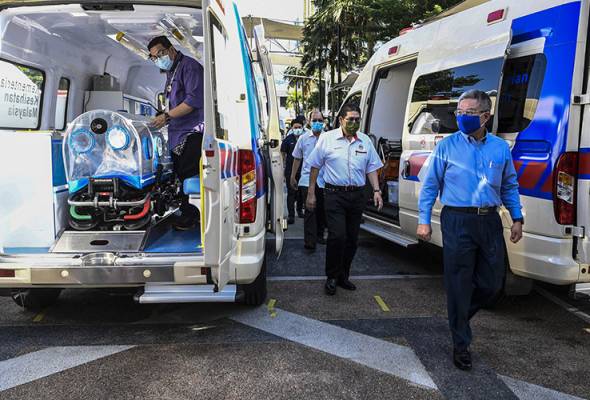
JOINT STATEMENT by:
• COLLEGE OF ANAESTHESIOLOGISTS, ACADEMY OF MEDICINE OF MALAYSIA
• MALAYSIAN SOCIETY OF ANAESTHESIOLOGISTS &
• MALAYSIAN SOCIETY OF INTENSIVE CARE
The College of Anaesthesiologists, Academy of Medicine of Malaysia; the Malaysian Society of Anaesthesiologists and the Malaysian Society of Intensive Care would like to respond on the press statement by the Health Minister, Datuk Seri Dr Adham Baba, as reported by the Bernama News Agency on 20th June 2021 with regards to the purchase of 500 negative pressure ambulances to transport Covid-19 patients.
We would like to affirm the Societies’ understanding of the necessity of ambulance services in transferring patients from their homes and/or Covid quarantine centres to hospitals for more urgent medical care. However, the use of negative pressure ambulances specifically has not been shown to confer any significant benefit.
Before embarking on any proposals, we suggest that clear data and evidence be obtained. Information that should be clarified related to Covid-19 infection transmission includes:
1. Have the current ambulance services caused an increase in the number of healthcare workers (HCW) being infected?
2. Has the current method of ambulance use caused more infections in other patients?
3. Has the use of the negative pressure ambulance in other countries led to the reduction of cases?
As we understand from the press statement, the use of a negative pressure ambulance will prevent transmission of Covid-19 infection to the HCW involved in the transfer of infected patients.
However, we need to highlight that, the destination that these patients are brought to, are not necessarily negative pressured areas in the emergency departments, intensive care units, or wards. As such the benefit of the negative pressure ambulances would be negligible especially when all HCW are in appropriate PPE during the transfer.
The most important places to have negative pressure should be in intensive care units (ICU), high dependency units (HDU), operating theatres (OT) or wards where the infectivity is high, and patients remain much longer in the facilities. Most hospitals are finding it difficult to maintain the negative pressure capabilities as the crucial high efficiency particulate air (HEPA) filters must be changed in a timely and appropriate fashion and may require special arrangements depending on where the outlet for the negative pressure is located. In fact, many ICUs are now considered open ICUs with positive rather than negative pressure ventilation being the norm.
Based on the Interim Recommendations for Emergency Medical Services Systems and 911 Public Safety Answering Points/Emergency Communication Centres First Responders in the United States during the Coronavirus Disease (COVID-19) Pandemic by the Centre for Disease Control and Prevention, the measures suggested for transportation of Covid-19 patients include:
a. All personnel should use appropriate Personal Protective Equipment.
b. The patient should be kept separated from others like the drivers, as much as possible.
c. Family members and other contacts should not ride in the transport vehicle.
d. Utilise air conditioning units on non-recirculating settings.
e. Use of exhaust fans to maximise air changes in both the driver and patient compartments of the ambulance.
To date, the role of negative pressure ambulances has not been mentioned in any recommendations or guidelines that we have come across. However, we note a publication from Hubei, China reported the availability of negative pressure ambulances corresponded to the decline in Covid-19 cases in Hubei province. Nevertheless, we believe there are various factors responsible in the successful containment of the Covid-19 cases in Hubei province, and not just the use of negative pressure ambulances.
At this point in time, our three Societies jointly believe that these ambulances are of no benefit in managing Covid-19 cases. We urge that future proposal(s) that is/are being evaluated must be evidence based. Without the evidence, there will be no clear goals and the outcome of care will not be improved despite the amount of money spent. The key word is improving outcome while spending prudently. Negative pressure ambulance DOES NOT IMPROVE OUTCOME nor help improve the Covid-19 situation with large monetary consequences.
Apart from the cost of a negative pressure ambulance, which is estimated to be between RM500,000 to RM600,000, there are also costs incurred with regular maintenance of the HEPA filters. The expenditure to change the HEPA filters is anticipated to be about RM3,000 to RM5,000 per ambulance per month.
Furthermore, the worst-case scenario is to have these ambulances sub- optimally or underperforming due to lack of funds to maintain them.
One immediate solution, to help mitigate the lack of ambulances availability, is to involve the many private ambulances and NGOs with ambulance services that can assist these transfers for a fee, thus alleviating the burden of the Ministry of Health ambulance services. The HCWs participating must be in relevant PPEs and vaccinated to reduce the risk of transmission.
At present, to ease the load and stress experienced by our front liners, who have been managing this pandemic now into the second year, is to increase the numbers of HCWs thus allowing intermittent reprieve from Covid-19 duties.
Our Societies recommend the immediate recruitment of junior doctors and nurses who have just graduated as well as converting all contract posts to permanent posts. Any surplus budget would best be spent investing in our young doctors and nurses. They have been and will be our last line of defence so that the care of the Covid-19 patients can be continued optimally.
Professor Dr Marzida Mansor
President
Malaysian Society of Anaesthesiologists
Dato Dr Jahizah Hassan
President
College of Anaesthesiologists, AMM
Professor Dr Mohd Basri Mohd Nor
President
Malaysian Society of Intensive Care




0 Comments
LEAVE A REPLY
Your email address will not be published